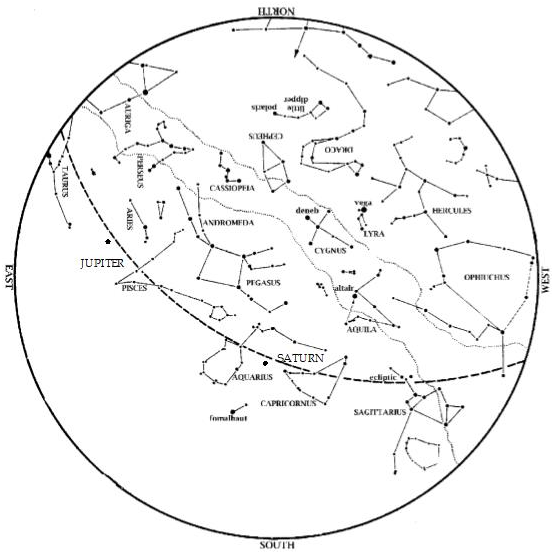Editor’s Note: We are looking up as HMNS Astronomer James Wooten explains the sky happenings for the month of October, including the solar eclipse occurring on October 14.
Saturn is now well placed for observing in early evening. Face southeast at dusk to observe it.
Jupiter is in the morning sky this month. Look in the west as day breaks. Jupiter also rises by 9:00 pm on October 1, and during evening twilight by Halloween night, when it is up virtually all night long. Jupiter is opposite the Sun, and up precisely all night long, the night of November 2-3.
Venus has entered the morning sky. Look for it high in the east at dawn this month.
Mars is lost in the Sun’s glare and out of sight for the rest of 2023.
Autumn represents sort of an ‘intermission’ in the sky, with bright summer stars setting at dusk, while bright winter patterns such as Orion have not yet risen. The ‘teapot’ of Sagittarius sets in the southwest early in the evening. The Summer Triangle is high in the west. Meanwhile, the Great Square of Pegasus is in the east, indicating that autumn has begun. The stars rising in the east are much dimmer than those overhead and in the southwest because when you face east at dusk in October, you face out of the Milky Way plane. The center of our Galaxy lies between Scorpius and Sagittarius, while the Summer Triangle is also in the galactic plane. When we face Pegasus, on the other hand, we face out of the plane of our galaxy. Pegasus, then, is a good place to look for other galaxies. Nearby constellations Andromeda and Triangulum (a small triangle) contain the spiral galaxies nearest to our own.

The Summer Triangle is high in the west. The ‘teapot’ of Sagittarius sets in the southwest. Saturn is in the south at dusk, with the brighter Jupiter in the east. The Great Square of Pegasus is high in the east at dusk. To the south and east, we see a vast dim area of sky known as the ‘Celestial Sea’, where only Fomalhaut stands out.
Moon Phases in October 2023
Last Quarter Oct. 6, 8:48 a.m.
New Oct. 14, 12:55 p.m.
1st Quarter Oct. 21, 10:29 p.m.
Full Oct. 28, 3:24 p.m.

The New Moon of October 14 passes in front of the Sun, causing a solar eclipse! This eclipse is not total because the Moon is just 4.5 days past apogee (farthest distance from Earth). With the Moon farther way than normal, its shadow tapers to a point before reaching the Earth, and the Moon cannot block the Sun completely from anywhere on the Earth’s surface. Observers in the path of this eclipse will see instead an annular eclipse, in which a ring of the Sun’s dusk remains visible around the silhouetted Moon. You can see a map of this path here: https://space.rice.edu/eclipse/
Houston is not quite on this path, so we’ll just see the Moon block almost 85% of the Sun.
The Full Moon of October 28 barely nicks the edge of Earth’s shadow, causing a partial lunar eclipse. However, this happens in daytime for North America. In general, if the Sun-Earth-Moon alignment is good enough for a solar eclipse, then it won’t be as good two weeks later for a lunar eclipse, and vice-versa.
Our George Observatory is now open every Saturday night for observing! Purchase tickets in advance on our website.
Clear Skies!
Looking for September’s sky happenings? See them here.






